#gunhild of denmark
Explore tagged Tumblr posts
Text
my little no (k)nut november in ink
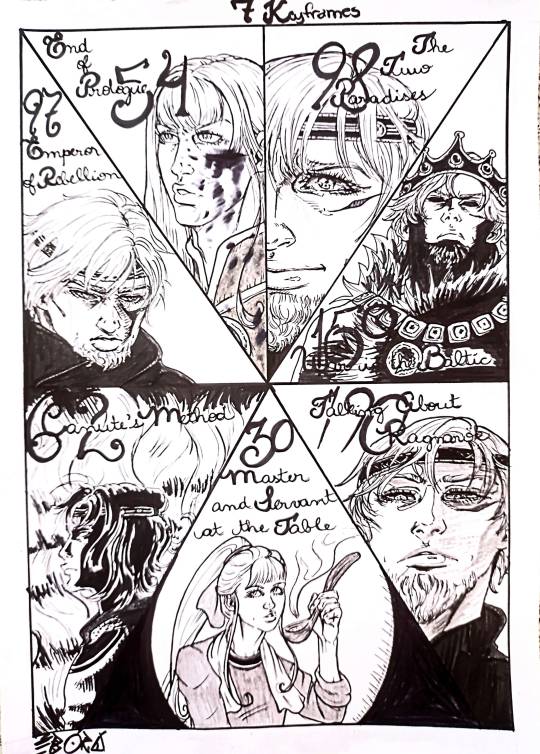


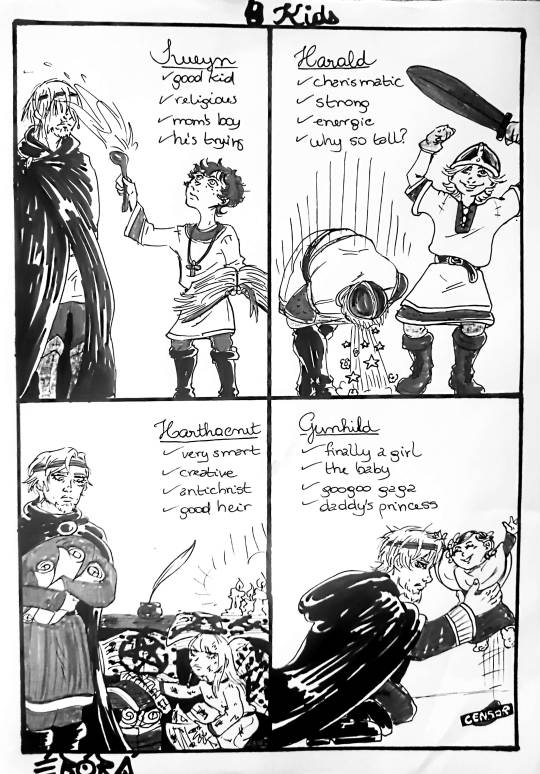


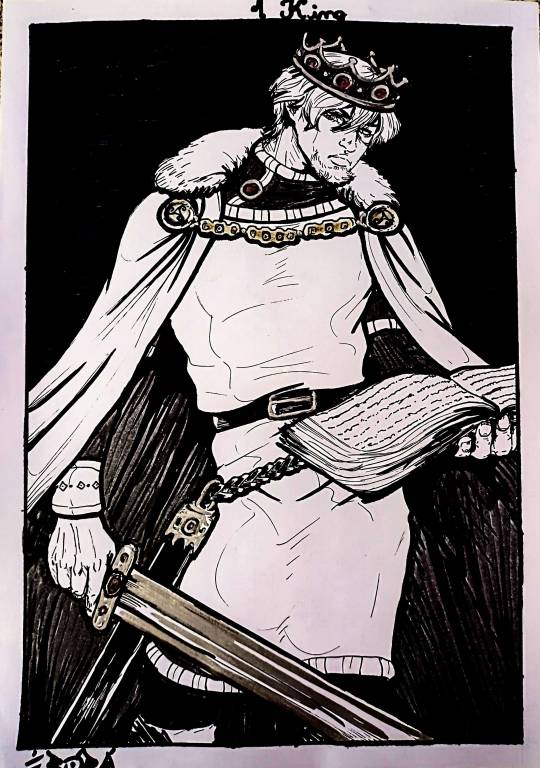
#vinland saga#prince canute#bretwalda canute#king canute#canute#prologue arc#slave arc#baltic sea arc#vinland arc#thorfinn#edmund ironside#aelfgifu#emma#jorund#sweyn knutsson#harald harefoot#harthacnut#gunhild of denmark#sweyn forkbeard#aethelred the unready#harald ii
30 notes
·
View notes
Text









HWS Female Holy Rome X England (Medieval Empire X Modern Empire)

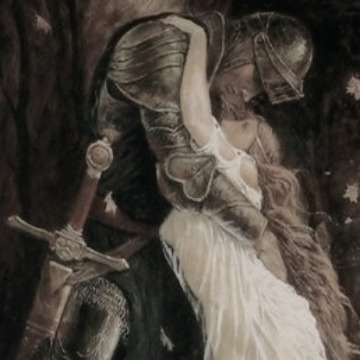
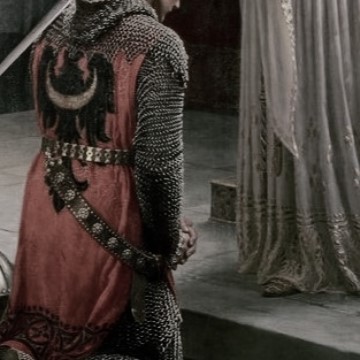
AESTHETIC MOOD BOARD
❝Many German and English writers were fond of expressing a common Anglo-Saxon-Germanic heritage prior to 1914, but in fact this largely disappeared after the Saxon migrations of late antiquity. Important contacts remained, especially with the renewed missionary activity promoted by the Carolingians, who often relied on qualified monks from the British Isles, like St Boniface, but otherwise England and the Empire evolved separately. While a sense of Saxon heritage may have played a part, both countries were sufficiently distant not to be immediate competitors. Ironically, this opened possibilities for royal marriages which, like Byzantine-imperial matches, were intended mainly to impress a domestic audience and avoid antagonizing a king’s nobles by tying him to one local family. Otto I married Alfred the Great’s granddaughter, Edith of Wessex, while Henry III married Gunhild, daughter of Knut of Denmark-England. Edith’s and Knut’s deaths ended any chances of a lasting alliance in both cases.
❝By contrast, connections in the high Middle Ages were more significant, if less celebrated in the nineteenth century. Emperor Henry V married Matilda, daughter of Henry I of England, in 1114 as a deliberate attempt to forge an alliance with the Anglo-Norman dynasty ruling much of Britain since 1066. It was hoped this would outflank a Franco-papal alliance threatening the Empire towards the end of the Investiture Dispute.❞
- Peter H. Wilson, Heart of Europe: A History of the Holy Roman Empire
❝On his mother's advice, Richard resigned the kingdom of England to Henry VI in order to receive it back as a fief of the empire. He was to pay his overlord £5,000 a year. Richard was now a vassal of Philip for his continental lands and a vassal of Henry VI for his island kingdom, but it seems that in England few, if any, were willing to acknowledge this, and that this part of the agreement was hushed up. At Henry's court, of course, it was regarded as the jewel in the crown.
❝On the day of his release, Henry VI and the princes of the empire had sent Philip and John a letter telling them that they would do all they could to help Richard if everything that had been taken while Richard was in captivity was not restored at once.❞
- John Gillingham, Richard I
❝On the morning of 6 August an imperial herald in full regalia rode through Vienna to the Jesuit church of the Nine Choirs of Angels. After climbing to the balcony, he summoned the inhabitants with a silver fanfare to announce the end of the Empire.
❝The Empire was certainly not dead by the late eighteenth century, and if it was sick, as Zedler and others suggested, it was not yet on life support. If revolutionary France had not intervened, the most likely prognosis was that the Empire’s socio-political order would have persisted further into the nineteenth century, but it is unlikely that this could have been sustained against the levelling and homogenizing forces unleashed by capitalism and industrialization around 1830.
❝By 1806, some leading intellectuals expressed the sense that the Empire had been sick for a long time and that its doctors had long given up hope. Goethe’s mother wrote two weeks after Francis II’s abdication that the news was not unexpected, ‘as when an old friend is very ill’. Later historians have expressed similar views that the Empire died ‘a “natural” death’ from old age, rather than having been murdered by Napoleon.❞
- Peter H. Wilson, Heart of Europe: A History of the Holy Roman Empire
❞By the end of the Napoleonic Wars, French imperialism had been curbed in North America, the Caribbean, and parts of Asia, but soon much of North and West Africa would be brought under French political and cultural influence. Spain was no longer a major power, but after the demise of its empire in the 1830’s its cultural dominance in the countries of South America remained: their economies urban, their governments strictly centralized, and their peoples devoutly Catholic in the Spanish style (Fernandez-Armesto, 2003). The Dutch and Portuguese empires were also in decline, and yet survived, resistant to radical change because of the commercial benefits derived from their overseas possessions. However, none of these four imperial orders came close to matching the size and power and wealth of the British Empire.
❝Encompassing nearly a quarter of the Earth’s land mass and a quarter of its population, the British Empire in the 19th century grew into the most extensive empire the world has ever seen.❞
- Douglas M. Johnston, In The Historical Foundations of World Order: The Tower and the Arena
#hetalia#hetalia rare pair#hreeng#hws england#aph england#nyo holy roman empire#nyo holy rome#hws holy roman empire#aph holy roman empire#aesthetic#moodboard#tragic romance#gloomy aesthetic#history#quotations#hetalia aesthetic#hetalia moodboard
12 notes
·
View notes
Text
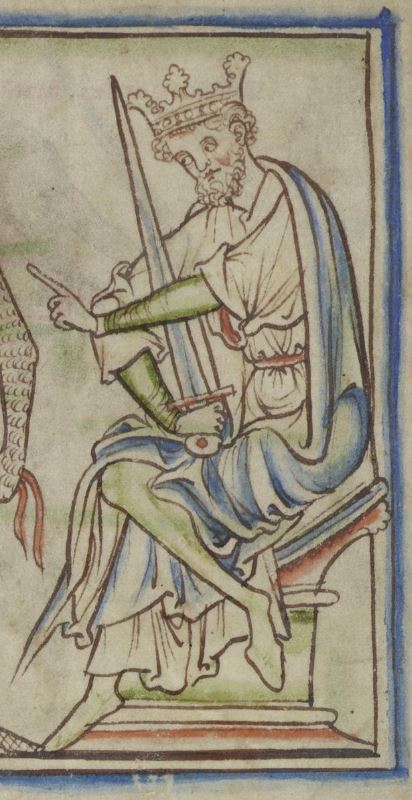

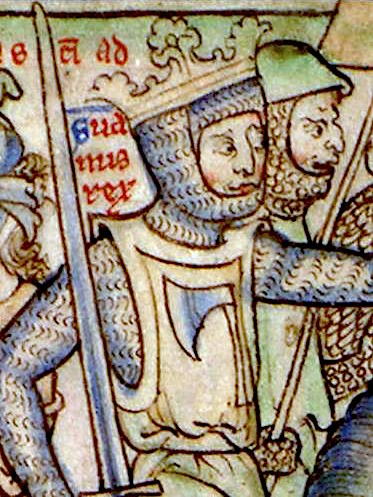
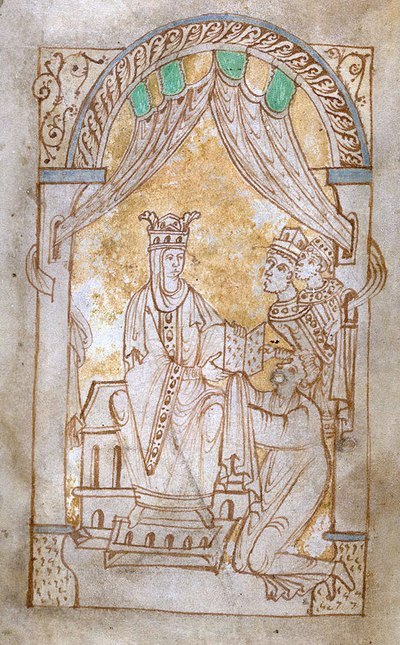


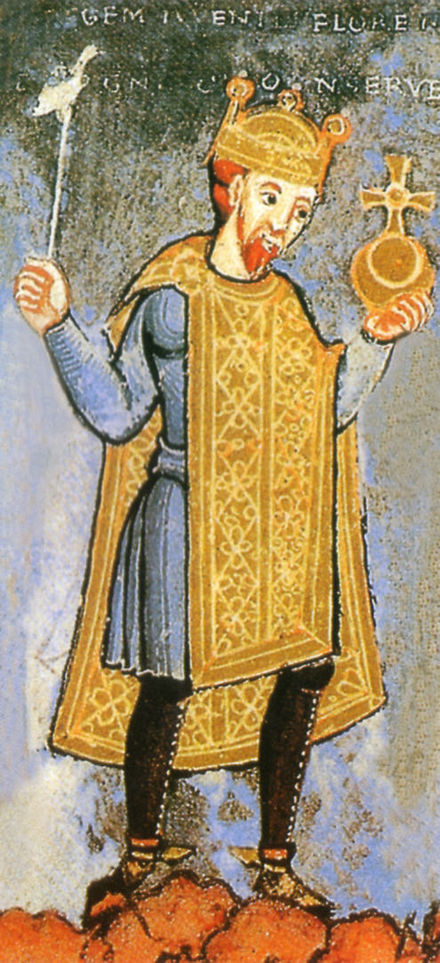
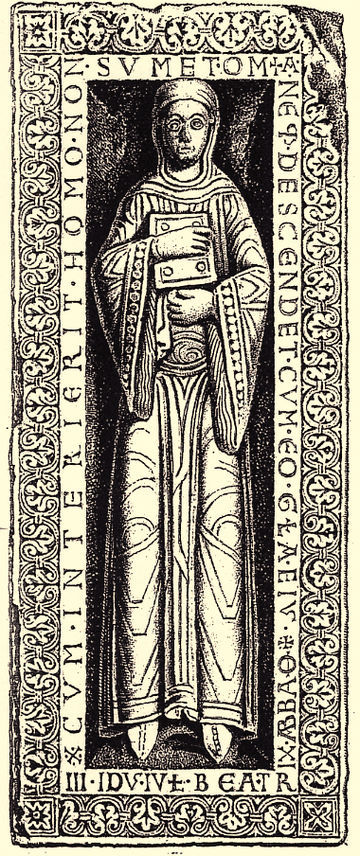


The Bastard Kings and their families
This is series of posts are complementary to this historical parallels post from the JON SNOW FORTNIGHT EVENT, and it's purpouse to discover the lives of medieval bastard kings, and the following posts are meant to collect portraits of those kings and their close relatives.
In many cases it's difficult to find contemporary art of their period, so some of the portrayals are subsequent.
1) Harold I of England (?- 1040), son of Knut the Great and his wife Ælfgifu of Northampton
2) Knut the Great (c. 990 – 1035), son of Sweyn Forkbeard and his wife Świętosława of Poland
3) Sweyn Forkbeard (963 – 1014), son Knut Danaást or Harald Bluetooth and his wife Tove or Gunhild
4) Emma of Normandy (c. 984 –1052), daughter of Richard I of Normandy and his wife Gunnor
5) Harthacnut/ Knut III of Denmark (c. 1018 – 1042), son of Knut the Great and his wife Emma of Normandy
6) Gunhilda of Denmark (c. 1020 – 1038), daughter of Knut the Great and his wife Emma of Normandy
7) Holy Roman Emperor Henry III (1016 -1056), son of Holy Roman Emperor Conrad II and his wife Gisela of Swabia
8) Beatrice of Franconia (1037 – 13 July 1061), daughter of Holy Roman Emperor Henry III and his wife Gunhilda of Denmark
9) Edward the Confessor (c. 1003 – 1066), son of Æthelred II of England and his wife Emma of Normandy
10) Ælfred Æþeling (c. 1012–1036), son of Æthelred II of England and his wife Emma of Normandy
#jonsnowfortnightevent2023#canonjonsnow#asoiaf#a song of ice and fire#day 10#echoes of the past#Beatrice of Quedlinburg#historical parallels#medieval bastard kings#bastard kings and their families#harold i of england#harold harefoot#cnut the great#knut the great#sweyn forkbeard#emma of normandy#harthacnut#cnut iii of denmark#Gunhilda of Denmark#Beatrice of Franconia#Beatrice I of Quedlinburg#holy roman emperor henry iii#henry the black#edward the confessor#Ælfred Æþeling#alfred aetheling
16 notes
·
View notes
Note
A quick infodump on Dietrich's "extra" knights from Scandinavian ballads:
Raavengaard or Raadengaard is from the ballad of Raadengaard and the Eagle. On the eve of his wedding, Sir Raadengaard goes hunting and is waylaid by an eagle-troll who lays claim to the animals of the forest and demands a fee. Raadengaard refuses to pay, so the eagle threatens to crash his wedding and snatch away him, his sister, or his bride, demanding he choose the one to be sacrificed. Raadengaard, however, is wiser than the eagle, and he carves binding runes into the tree the eagle is perched on, magically gluing the eagle to the branch until Raadengaard holds his wedding in peace and eagle starves.
Little Mimering is in two ballads. The first states that he is the smallest man in Dietrich's kingdom, and describes how he fights and befriends Wudga. The second follows the folklore pattern of the Unlikely Champion rescuing a falsely accused lady. The earliest forms of the ballad referred to Holy Roman Emperor Henry III and his wife Gunhild, daughter of the king of Scandinavia and England, Canute the Great. Gunhild is accused of adultery by a disgruntled admirer, and cannot find a champion to defend her, except for a little child. Against all odds he wins the duel, and Gunhild, freed from the threat of death, promptly divorced her way too paranoid husband. In English folklore, the story has become attached to Eleanor of Aquitaine and her husband Henry II. In the Scandinavian ballads, Mimering's name was attached to the story, no doubt because he was already a famous Tom Thumb type of character. As a result the king being duped into thinking his wife cheated...happens to be Dietrich.
Count Genselin/Guncelin/Jansalin is from the ballad of the same name. The Faroese adaptation of his story has it be a rather straightforward one, where young Genselin tells his father he wants to sally forth and prove his manhood. HIs parents give him a good horse and tells him he shouldn't wear his helmet and draw his sword (i.e. he has nothing to fear) until he runs into the champions Ivar Blue and Valuvant. He dresses himself finely with a scarlet sash all around his sides, and rides his horse with golden bit and saddle rings. When he rides forth, he finds Ivar Blue and snaps on his helmet with such forth that his father hears it from a long distance away and is proud his son has put on a helmet for the first time. Genselin kills Ivar Blue, then heads to Valuvant's catle. He is intimidated by Valuvant's fine armor and entourage, so he ducks into the woods, catches Valuvant alone, and duels him. Genselin wins and spares Valuvant's life in exchange for taking his fiancee Solinta, but giving Valuvant his own sister Gunhild in recompense. He celebrates his wedding and goes home with his loving bride. In Denmark, the ballad has become a humorous parody. Genselin fights and spares Ivar Blue in exchange for Ivar's sister Solinta, who turns out to look like a female version of Thor, down to the giant size and burning bloodshot eyes. They have a grand wedding, inviting all of greatest heroes of the age. All guests are gigantic (and/or pagan), with Mimering being the smallest one (and/or the only Christian). Kriemhild and Brynhild help Solinta put on an armored wedding dress. She eats several bulls and drinks several kegs of beer, and then smashes a hole into the wedding hall when she can't get through the door and smashes the wedding bench by sitting on it. She dances with a giant troll and crushes 15 knights to death in the process. Genselin later shows up as a Hunnish knight at Kriemhild's revenge feast.
Svend Vovend (Sven the Swan-White) is a berserker warrior. He is the nephew of either Dietrich or Wudga on his mother's side. His father, King Esmer or Espen, is either a reference to Asprian, the Aspen tree, or the general direction of the east, as in the English ballad King Eastmer. He sits in his bower playing his harp, but his mother makes him go avenge his father. He tells her he might not be coming home, and she curses him. He raids a series of castles, killing their champions, and also enters into riddle contests with various shepherds he asks for directions. He finds and kills the giant who killed his father, and then goes on to his uncle's castle. Despite his uncle's offer for him to stay, he goes home and finds his mother in the company of witches. He kills them all, then plays his harp until all the strings break. Finally, he goes and kidnaps a king's daughter, marries her, and settles down. The ballad is strangely cryptic.
And then if you get into ballads like Dietrich's Champions against the Giant Langbane or King Dietrich in Birtingsland, there's an entire list of champions, who all amount for nothing more than cameos.
... ngl, Solinta in her "basically just Fem!Thor" version sounds AMAZING and I love that she's apparently friendly with Kriemhild and Brunhild. at least enough for both of them to help her dress up for the wedding.
Also, I never expected to see a link (well, technically) between Dietrich and Eleanor of Aquitaine of all people but, at this point, I suppose I shouldn't even be surprised. XD
Svend sounds like a hell of a guy. Even if I'm kind on his mom's side... she may consort with witches, but when your mother tells you to go avenge a member of your family, you do exactly as she says, and without complaining! *squints at Ragnar's sons and at Gudrun's*
2 notes
·
View notes
Text
Monarch #8
These were getting wordy, so I'm going to try keep them short and pithy. I encourage you to look them up if you want to know more, and why wouldn't you? ;)
Who: Sweyn Forkbeard Also Known As: Sveinn Haraldsson tjúguskegg (Old Norse), Svend Tveskæg (Danish), Who He's Not: Forkbeard (phycis phycis) Where: England, Denmark (986-1014), Norway (999/1000 - 1013/14) Succeeded: Æthelred the Unready (and was also succeeded by Æthelred the Unready) Reigned: 1013-1014 Born: 17th April, 963, Denmark, the son of Knut Danaást or Harald Bluetooth and Tove or Gunhild. Died: 3rd February, 1014 Buried: Roskilde Cathedral (Denmark) or Lund Cathedral (Sweden) Consorts/Children: First married Świętosława and also possibly Sigrid the Haughty (complicated and possibly mythical), and between them (or not) was (were?) the mother(s) of Harald, who became king of Denmark, Cnut, who became king of England, Estrid, Gytha, Gunnhild, Santslaue, and Thyra.
Sweyn Facts! He revolted against his father and seized the throne of Denmark!
Joined forces with the king of Sweden against Norway, and they divided the kingdom between them!
Allegedly in response to the St. Brice's Day Massacre, where supposedly his sister Gunhilde was killed, Sweyn invaded England. He ruled a year or so before dying. His eldest son succeeded him as king of Denmark, and the Danelaw proclaimed Cnut as king of England. The English sent for Aethelred, and drove Cnut out. He came back in 1016.
It's hard to have any more King Sweyn of England facts because he lasted such a short time.
Wife Facts! A Polish princess, the daughter of Mieszko I, Świętosława is a presumed name, based on the fact that a sister of Cnut had the name. She may have been a combination of two wives of Sweyn - Gunhild (the Polish princess, Cnut's mother) and Sigrid the Haughty, the mother of Sweyn's daughter, Estrid. Whatever her name, or whether she is one or two women, this wife (wives) is (are) the mother(s) of Harald II of Denmark, Cnut of England, and Estrid.
#monarchs#monarchy#kings of england#queens of england#sweyn forkbeard#Świętosława#Sigrid the Haughty
0 notes
Text
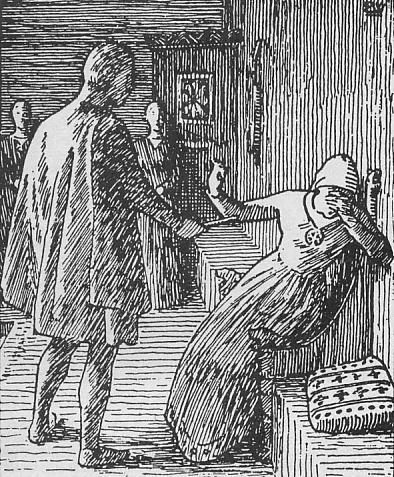
Tyra of Denmark was a 10th-century Danish princess. She was the spouse of both King Olav I of Norway and of Styrbjörn Starke, prince of Sweden.
Tyra was daughter of the Danish king Harald Bluetooth and thus a sister to King Sweyn Forkbeard. She was first married to the Swedish prince and throne claimant Styrbjörn Starke (Styrbjörn the Strong), son of King Olof Björnsson. However Styrbjörn Starke died in the Battle of Fýrisvellir (986) near Uppsala fighting with his uncle King Eric the Victorious for the throne of Sweden.
According to Snorri Sturluson, she was next betrothed to the Wendish king Burislav, as part of a Danish-Wendic peace agreement negotiated by King Sweyn Forkbeard. As part of the agreement, Sweyn married Gunhild of Wenden who was the sister of Burislav. However, after her hunger strike, Burislav sent her back to Denmark.
She subsequently arranged to have herself married to Olaf Tryggvason, King of Norway, to the displeasure of her brother Sweyn. When Olaf married her, Sweyn refused to pay her promised dowry. Olaf subsequently set out for Wendland to seek allies for a war on Denmark. On the way Olaf was ambushed by Sweyn and an alliance which included Olof Skötkonung, King of Sweden, and Eirik Hákonarson, Jarl of Lade. The resulting Battle of Svolder ended in the death of the Norwegian king (c. 1000). According to legend, Queen Tyra subsequently committed suicide by starvation after receiving news of her husband's death at the battle.
1 note
·
View note
Text
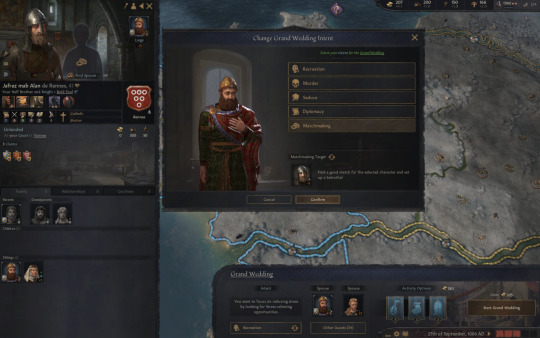
We set up our Grand Wedding and Changed the Intent to that of Matchmaking during the festivities for Duke Konan's unmarried Half-Brother Jafrez. The entire Grand Wedding operations cost 205 gold to orchestrate.
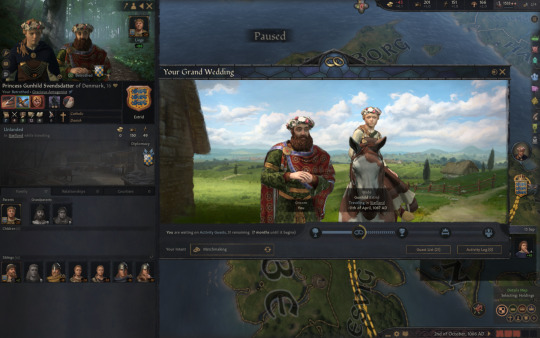
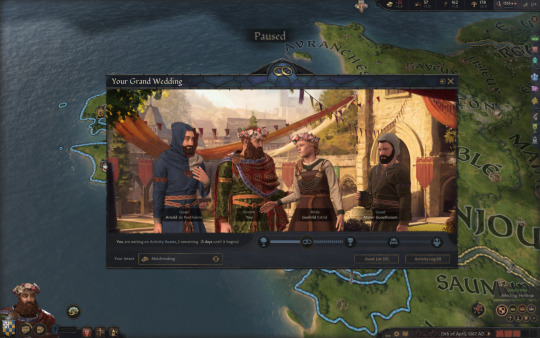
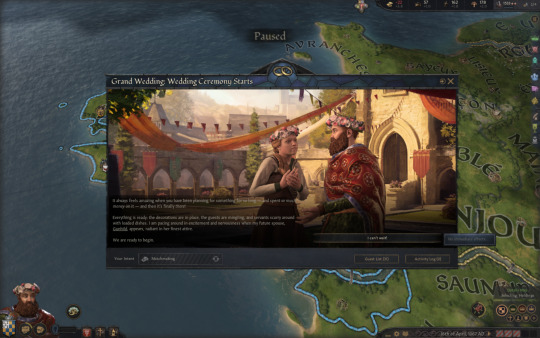

The Grand Wedding celebrations kickstart with Princess Gunhild traveling all the way from Sjaelland, Denmark to Gwened, Vannes, Brittany.

Just before the Wedding Ceremony takes place, Gunhild's brother Prince Svend complains about the wedding arrangements non-stop. There were a total of 3 events in which he participated as an antagonist in every single one of them, out of which I'm choosing to only show one. Anywho, Duke Konan manages to placate him and stop the constant complaints from Svend.
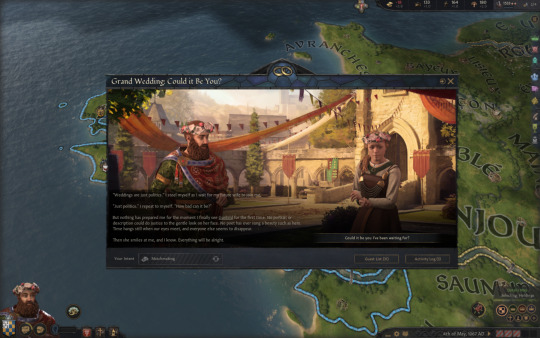

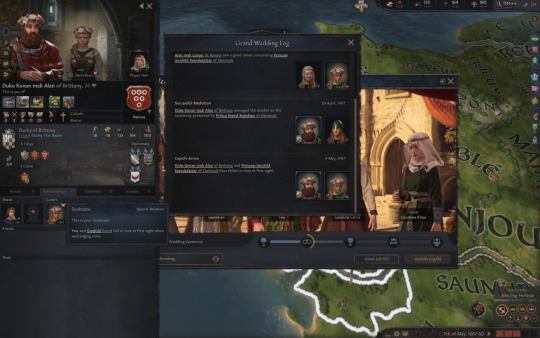
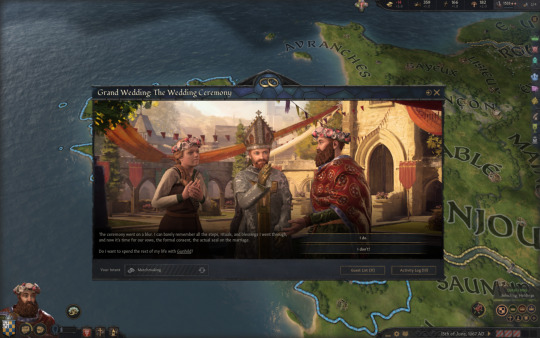
A sweet little thing happened just before the couple said their vows, Duke Konan and Princess Gunhild have fallen in love at first sight and became Soulmates. In front of officiant Bishop Guobrian, they said their vows of "I do".


Then begins the Wedding Banquet segment of the celebrations. Duke Konan's guest Gwilherm manages to trip and caught his clothes on fire from the fire dancers' torch, to which Duke Konan responds in his hysterically Craven manner: "EVERYONE FOR THEMSELVES!"
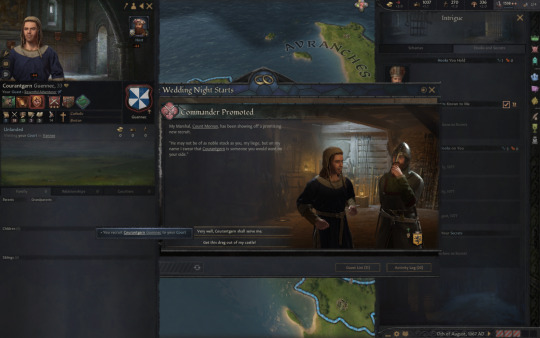
In the middle of festivities, Duke Konan promotes a Knight who was recruited by his Marshal Count Morvan, named Courantgern Guennec who is Stubborn, Brave, Lustful and Hale, not to mention a Skilled Tactician.
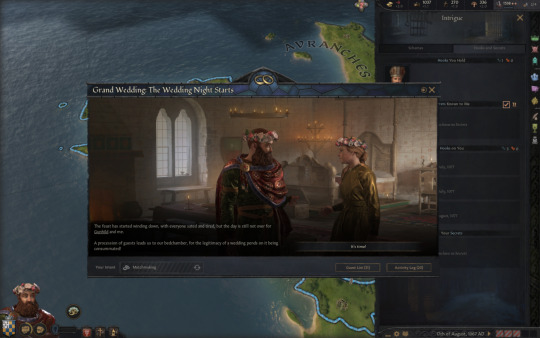
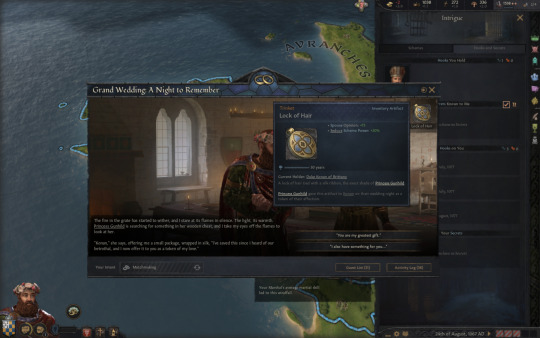
Just before the Bedding Ceremony, Princess Gunhild gifts Duke Konan a Lock of her Hair tied with a silk ribbon as a token of her affection.
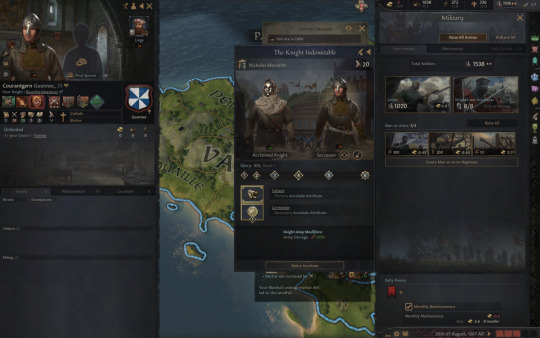
The Knight Indomitable Accolade has found its worthy successor in the form of Courantgern Guennec who is Brave which is a requirement for the Valiant attribute.
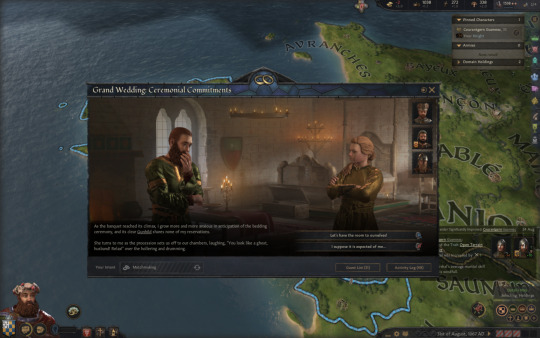



Finally, the couple get jiggy with it during the Bedding Ceremony and lay with each other. After that, the Grand Wedding celebrations come to an end. Our Matchmaking Intent for our Half-Brother failed as there were no eligible single women available for him. However, we gained a whole host of good modifiers, prestige and opinion boosts.
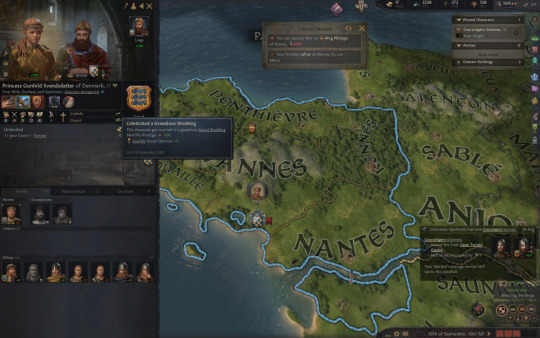
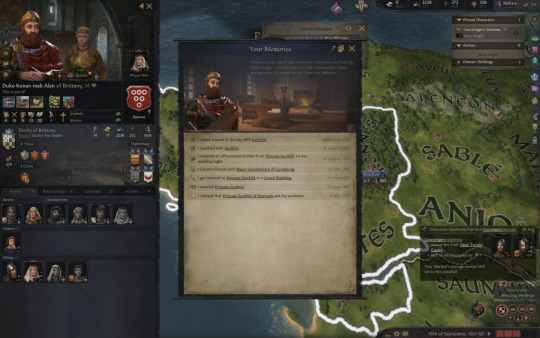
After the Grand Wedding, we note that Princess Gunhild has changed into her Duchess clothes and Duke Konan gained 2 memories of having laid with her.
1 note
·
View note
Text
Holidays 2.21
Holidays
Alka Seltzer Day
Armed Forces Day (South Africa)
Ben Appreciation Day
Breakup Day
Card Reading Day
Communist Manifesto Day
Father Lini Day (Vanuatu)
International Mother Language Day (UN)
International Tourist Guide Day
King Harald V Day (Norway)
Kurt Cobain Day (Aberdeen, Washington)
Language Movement Day (a.k.a. Shahid Dibosh; Bangladesh)
Locomotive Day
Mental Health Nurses Day (UK)
Musikahan Festival begins (Philippines) [thru 2.27]
National Pillow on Head Day
National Waste Awareness Day (Indonesia)
Nina Simone Dau (Tyron, North Carolina)
Red Books Day
Remember the Funniest Thing Your Child Ever Did Day
Robert Gabriel Mugabe National Youth Day (Zimbabwe)
Sandino Day (Nicaragua)
Sewing Machine Day
Single-Tasking Day
Washington Monument Day
Food & Drink Celebrations
Drink It Now Day
National Biscuits & Gravy Day
National Grain-Free Day
National Malört Day
National Sticky Bun Day
3rd Tuesday in February
Travel Africa Day [3rd Tuesday]
Independence Days
Aulpannian Shatidom (Declared; 2021) [unrecognized]
South Formosa (Declared; 2021) [unrecognized]
Feast Days
Boris Karloff Day (Church of the SubGenius; Saint)
Daniel, priest, and Verde, virgin (Christian; Martyrs)
Day Sacred to the Goddess Muta (a.k.a. Laranda; Ancient Rome)
Feast of Peace and Love (Ancient Rome)
Felix of Hadrumetum (Christian; Saint)
Feralia (Old Roman Spirits Festival)
German and Randaut (Christian; Martyrs)
Horace (Positivist; Saint)
Mathilda (Muppetism)
Pepin of Landen (Christian; Saint)
Peter Damian (Christian; Saint)
Randoald of Grandval (Christian; Saint)
Seize a Sausage Day (Pastafarian)
Severianus, Bishop of Scythopolis (Christian; Saint)
Shrove Tuesday [Day before Ash Wednesday] (a.k.a. ...
Brose and Bannock Day (a.k.a. Bannocky Day; Scotland)
Bursting Day (Iceland, Ireland)
Carnival / Carnaval
Carnival Tuesday
Carriacou Carnival (Grenada)
Fasching (Austria, Germany, Switzerland)
Faschingsdienstag (Germany, Liechtenstein)
Fasnacht (Austria, Germany)
Fasten Day (Old England)
Fastelavens (Norway)
Fastelavn (Denmark)
Fastens-een or Fasten’s E’en (Scotland)
Fastnacht Day (Pennsylvania Dutch Country)
Fat Tuesday
Fettisdagen (Sweden)
IHOP National Pancake Day
International Pancake Day
Máirt Inide (Ireland)
Malasada Day (Hawaii)
Mardi Gras
Martes de Carnaval (Argentina, Spain)
Martedì Grasso (Italy)
Nickanan Night (Cornwall)
Pączki Day (Buffalo, Chicago and Hamtramck, Michigan)
Pancake Day (or Pancake Tuesday)
Read Lips Day
Sharp Tuesday
Shrovetide (Day 3 of 3)
Shuttlecock Day (Leicester, Yorkshire)
Sprengidagur (or Bursting Day; Iceland)
Terça-feira Gorda (or Carnival of Madeira; Madeira, Portugal)
Užgavėnės (Lithuania)
Vastlapäev (Estonia)
Violet Tuesday
Talk to a Goldfish Day (Pastafarian)
Yakuyoke Festival (a.k.a. Toshi-no-Matsuri; honoring Kami for bountiful rice harvest; Shinto)
Lucky & Unlucky Days
Fortunate Day (Pagan) [8 of 53]
Sakimake (先負 Japan) [Bad luck in the morning, good luck in the afternoon.]
Umu Limnu (Evil Day; Babylonian Calendar; 9 of 60)
Premieres
Alice at the Rodeo (Disney Cartoon; 1927)
Anna Christie (Film; 1930
Avatar: The Last Airbender (Anime TV Series; 2005)
Bottle Rocket (Film; 1996)
Captains of the Clouds (Film; 1942)
The Conqueror (Film; 1956)
Emma (Film; 2020)
King of America, by Elvis Costello (Album; 1986)
9-1/2 Weeks (Film; 1986)
Old School (Film; 2003)
Real Time with Bill Maher (TV Series; 2003)
Rock and Roll, by Led Zeppelin (Song; 1972)
The Wind Rises (Animated Studio Ghibli Film; 2014)
Today’s Name Days
Enrica, Gunthild, Petrus (Austria)
Damir, Natalija, Petar (Croatia)
Lenka (Czech Republic)
Samuel (Denmark)
Aavo, Auvo, Avo (Estonia)
Keijo (Finland)
Damien (France)
Enrica, Gunhild, Peter, Petrus (Germany)
Efstathios, Evstathios, Stathis (Greece)
Eleonóra (Hungary)
Eleonora, Leopoldo, Nora, Pier Damiani (Italy)
Eleonora (Latvia)
Eleonora, Feliksas, Kęstutis, Žemyna (Lithuania)
Celine, Samuel, Selma (Norway)
Eleonora, Feliks, Fortunat, Kiejstut, Teodor, Wyszeniega (Poland)
Eustatie, Timotei (Romania)
Eleonóra (Slovakia)
Pedro (Spain)
Hilding (Sweden)
Dallin, Doug, Douglas, Duff (USA)
Today is Also…
Day of Year: Day 52 of 2023; 313 days remaining in the year
ISO: Day 2 of week 8 of 2023
Celtic Tree Calendar: Nuin (Ash) [Day 3 of 28]
Chinese: Month 2 (Yi-Mao), Day 2 (Geng-Xu)
Chinese Year of the: Rabbit 4721 (until February 10, 2024)
Hebrew: 30 Shevat 5783
Islamic: 30 Rajab II 1444
J Cal: 22 Xin; Oneday [22 of 30]
Julian: 8 February 2023
Moon: 3%: Waxing Crescent
Positivist: 24 Homer (2nd Month) [Horace]
Runic Half Month: Sigel (Sun) [Day 13 of 15]
Season: Winter (Day 63 of 90)
Zodiac: Pisces (Day 2 of 29)
0 notes
Text
Holidays 2.21
Holidays
Alka Seltzer Day
Armed Forces Day (South Africa)
Ben Appreciation Day
Breakup Day
Card Reading Day
Communist Manifesto Day
Father Lini Day (Vanuatu)
International Mother Language Day (UN)
International Tourist Guide Day
King Harald V Day (Norway)
Kurt Cobain Day (Aberdeen, Washington)
Language Movement Day (a.k.a. Shahid Dibosh; Bangladesh)
Locomotive Day
Mental Health Nurses Day (UK)
Musikahan Festival begins (Philippines) [thru 2.27]
National Pillow on Head Day
National Waste Awareness Day (Indonesia)
Nina Simone Dau (Tyron, North Carolina)
Red Books Day
Remember the Funniest Thing Your Child Ever Did Day
Robert Gabriel Mugabe National Youth Day (Zimbabwe)
Sandino Day (Nicaragua)
Sewing Machine Day
Single-Tasking Day
Washington Monument Day
Food & Drink Celebrations
Drink It Now Day
National Biscuits & Gravy Day
National Grain-Free Day
National Malört Day
National Sticky Bun Day
3rd Tuesday in February
Travel Africa Day [3rd Tuesday]
Independence Days
Aulpannian Shatidom (Declared; 2021) [unrecognized]
South Formosa (Declared; 2021) [unrecognized]
Feast Days
Boris Karloff Day (Church of the SubGenius; Saint)
Daniel, priest, and Verde, virgin (Christian; Martyrs)
Day Sacred to the Goddess Muta (a.k.a. Laranda; Ancient Rome)
Feast of Peace and Love (Ancient Rome)
Felix of Hadrumetum (Christian; Saint)
Feralia (Old Roman Spirits Festival)
German and Randaut (Christian; Martyrs)
Horace (Positivist; Saint)
Mathilda (Muppetism)
Pepin of Landen (Christian; Saint)
Peter Damian (Christian; Saint)
Randoald of Grandval (Christian; Saint)
Seize a Sausage Day (Pastafarian)
Severianus, Bishop of Scythopolis (Christian; Saint)
Shrove Tuesday [Day before Ash Wednesday] (a.k.a. ...
Brose and Bannock Day (a.k.a. Bannocky Day; Scotland)
Bursting Day (Iceland, Ireland)
Carnival / Carnaval
Carnival Tuesday
Carriacou Carnival (Grenada)
Fasching (Austria, Germany, Switzerland)
Faschingsdienstag (Germany, Liechtenstein)
Fasnacht (Austria, Germany)
Fasten Day (Old England)
Fastelavens (Norway)
Fastelavn (Denmark)
Fastens-een or Fasten’s E’en (Scotland)
Fastnacht Day (Pennsylvania Dutch Country)
Fat Tuesday
Fettisdagen (Sweden)
IHOP National Pancake Day
International Pancake Day
Máirt Inide (Ireland)
Malasada Day (Hawaii)
Mardi Gras
Martes de Carnaval (Argentina, Spain)
Martedì Grasso (Italy)
Nickanan Night (Cornwall)
Pączki Day (Buffalo, Chicago and Hamtramck, Michigan)
Pancake Day (or Pancake Tuesday)
Read Lips Day
Sharp Tuesday
Shrovetide (Day 3 of 3)
Shuttlecock Day (Leicester, Yorkshire)
Sprengidagur (or Bursting Day; Iceland)
Terça-feira Gorda (or Carnival of Madeira; Madeira, Portugal)
Užgavėnės (Lithuania)
Vastlapäev (Estonia)
Violet Tuesday
Talk to a Goldfish Day (Pastafarian)
Yakuyoke Festival (a.k.a. Toshi-no-Matsuri; honoring Kami for bountiful rice harvest; Shinto)
Lucky & Unlucky Days
Fortunate Day (Pagan) [8 of 53]
Sakimake (先負 Japan) [Bad luck in the morning, good luck in the afternoon.]
Umu Limnu (Evil Day; Babylonian Calendar; 9 of 60)
Premieres
Alice at the Rodeo (Disney Cartoon; 1927)
Anna Christie (Film; 1930
Avatar: The Last Airbender (Anime TV Series; 2005)
Bottle Rocket (Film; 1996)
Captains of the Clouds (Film; 1942)
The Conqueror (Film; 1956)
Emma (Film; 2020)
King of America, by Elvis Costello (Album; 1986)
9-1/2 Weeks (Film; 1986)
Old School (Film; 2003)
Real Time with Bill Maher (TV Series; 2003)
Rock and Roll, by Led Zeppelin (Song; 1972)
The Wind Rises (Animated Studio Ghibli Film; 2014)
Today’s Name Days
Enrica, Gunthild, Petrus (Austria)
Damir, Natalija, Petar (Croatia)
Lenka (Czech Republic)
Samuel (Denmark)
Aavo, Auvo, Avo (Estonia)
Keijo (Finland)
Damien (France)
Enrica, Gunhild, Peter, Petrus (Germany)
Efstathios, Evstathios, Stathis (Greece)
Eleonóra (Hungary)
Eleonora, Leopoldo, Nora, Pier Damiani (Italy)
Eleonora (Latvia)
Eleonora, Feliksas, Kęstutis, Žemyna (Lithuania)
Celine, Samuel, Selma (Norway)
Eleonora, Feliks, Fortunat, Kiejstut, Teodor, Wyszeniega (Poland)
Eustatie, Timotei (Romania)
Eleonóra (Slovakia)
Pedro (Spain)
Hilding (Sweden)
Dallin, Doug, Douglas, Duff (USA)
Today is Also…
Day of Year: Day 52 of 2023; 313 days remaining in the year
ISO: Day 2 of week 8 of 2023
Celtic Tree Calendar: Nuin (Ash) [Day 3 of 28]
Chinese: Month 2 (Yi-Mao), Day 2 (Geng-Xu)
Chinese Year of the: Rabbit 4721 (until February 10, 2024)
Hebrew: 30 Shevat 5783
Islamic: 30 Rajab II 1444
J Cal: 22 Xin; Oneday [22 of 30]
Julian: 8 February 2023
Moon: 3%: Waxing Crescent
Positivist: 24 Homer (2nd Month) [Horace]
Runic Half Month: Sigel (Sun) [Day 13 of 15]
Season: Winter (Day 63 of 90)
Zodiac: Pisces (Day 2 of 29)
1 note
·
View note
Text

Sigrid the Haughty - Unknown Date/Artist
"Her hand was next sought by Olaf Tryggvasson, the king of Norway, but he would have required that she convert to Christianity. She told him to his face, "I will not part from the faith which my forefathers have kept before me". In a rage, Olaf struck her with a glove, and Sigrid calmly told him, "This may some day be thy death". Sigrid then proceeded to create a coalition of his enemies to bring about his downfall. She allied Sweden with Denmark, marrying the widower Sweyn Forkbeard who had already been feuding with Olaf. Sweyn had sent his sister Tyri to marry the Wendish king Burislav, who had been the father of Sweyn's first wife, Gunhild. Tyri fled and married Olaf, goading him into conflict with her brother, while Sigrid inflamed Sweyn against her former suitor. This shared animosity would lead to the Battle of Swold, in which Olaf fell."
-taken from Wikipedia, Source: Heimskringla Ch. 68, 108, 122
https://paganimagevault.blogspot.com/2020/04/sigrid-haughty-unknown-date.html
#sigrid#viking age#europe#european history#pagan#medieval literature#medieval#swedish history#sweden#middle ages#paganism#germanic#scandinavian#norse
19 notes
·
View notes
Photo
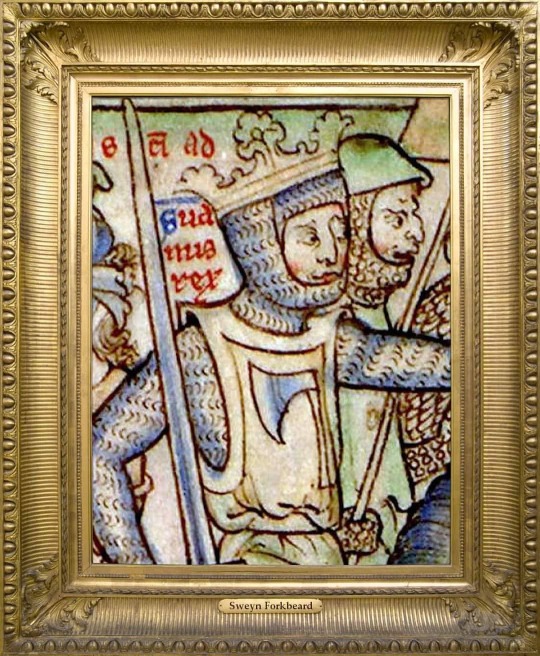
Sweyn Forkbeard Old Norse: Sveinn Haraldsson tjúguskegg; Danish: Svend Tveskæg . king of Denmark from 986 to 1014. . King of Norway: 986–995 & 1000–1014. . King of the English: 1013–1014 . Born: c. 960, Denmark Parents: Harald “Bluetooth” Gormsson (Old Norse: Haraldr Gormsson; Danish: Harald Blåtand Gormsen, died c. 985/86),king of Denmark & Norway.by either Gunhild or Tove. . House of: Denmark . Marriages & children; . The sources about the wife or wives of Sweyn are contradictory, but the two names we have are; . (1.) Sigrid the Haughty (2.) Gunhild of Wenden . Children from these marriages are; . Harald II of Denmark (c. 996–998 − c. 1018) Cnut the Great Estrid Svendsdatter (990/997 – 1057/1073) Gytha Gunnhild Santslaue Thyra . Died: 3 February 1014 (aged 53-54), Gainsborough, Lincolnshire, England Burial: Roskilde Cathedral or St. Trinity in Lund. . Successor: As king of Denmark: Harald II of Denmark (eldest son) King of Norway: Olaf II of Norway King of England: Æthelred the Unready. . . . #kingsandqueensofgreatbritain #kingsandqueens #Monarchy #RoyalHistory #Royalty #Royals #Portraitpainting #historyinpictures #Britishhistory #BritishMonarchy #Monarch #EnglishHistory #EnglishMonarchy #Medievalhistory #Danes #Medievaltimes #HistoryFacts #medieval #MedievalEngland #Anglosaxons #Anglosaxon #kingoftheEnglish #Sweyn #SweynForkbeard #Vikings #KingofDenmark #Kingofnorway (at London, United Kingdom) https://www.instagram.com/p/CRowEolM0mm/?utm_medium=tumblr
#kingsandqueensofgreatbritain#kingsandqueens#monarchy#royalhistory#royalty#royals#portraitpainting#historyinpictures#britishhistory#britishmonarchy#monarch#englishhistory#englishmonarchy#medievalhistory#danes#medievaltimes#historyfacts#medieval#medievalengland#anglosaxons#anglosaxon#kingoftheenglish#sweyn#sweynforkbeard#vikings#kingofdenmark#kingofnorway
3 notes
·
View notes
Text


Gyda: Not right now haha! No one else is here except Hilda and I… But I think they’re all doing well. I get along well enough with the others. Gyda: Gunhild/Denmark is my girlfriend, so I see her the most other than Hilda. Lempi/Finland is a friend of mine I suppose… She’s sort of odd though. Nothing against that or her of course! Olga/Sweden is also a friend, but I don’t see her very often anymore. Since I’m not doing a whole lot anymore I don’t even really see her for business affairs… I miss her sometimes.
Hilda: I love Olga! She’s the greatest. Whenever she comes to see me we always go and visit Skógar so we can go hiking and swim. I wish I could see her more, though…
Hilda: Yeah, no. I don’t know if you’ll be able to meet them. Definitely not today, though. Gunhild…
[ / She sighs, rolling her eyes, before she continues. ]
Hilda: … Is probably busy with work. Lempi and Olga are all the way in Kittilä, and even then they don’t really hang out with us much. You’d be more likely to see Lempi, though, since she spends time with Mamma when I can’t be here.
Hilda: Mhmm… Anyways!

Hilda: Oh!

Hilda: That’s my girlfriend, Gretchen! Zhi Ruo if that’s easier, or Hong Kong for those of you who didn’t know. Oscar took that picture of us whenever we all went to Kvaløya to go whale watching.
Hilda: She’s really sweet and just wonderful! She’s kind of got a boomer mentality though, hah! Gyda: Aww… You’re “simping” and it shows haha!
Hilda: Wh- HUH? Who taught you that?
Gyda: Björn did! I hope I used that right…
Hilda: I’ll kill him. I’ll actually kill him.
Hilda: Speaking of Björn, though…

Hilda: Hel yeah the giant cyclops and I get along! But it’s not just us two. All of us Icelanders get along great!

Hilda: We don’t get to hang out in person a lot because i’m not back home often. But whenever I am we all meet up in Reykjavík to hang out and go partying! Hilda: … After we’re done working, of course.
Hilda: Sigrún’s kind of like our designated driver. It’s not that she’s not capable of acting outta pocket, but she’s smart enough to know not to whenever us four are together! Hilda: Björn and I are a real rowdy pair whenever we get together, but don’t let my sweet little Emil fool you. He’s no better than us! I actually have videos of his most embarrassing moments saved onto an actual hard drive, just in case he tries to act up. I love him a lot!
Hilda: So yeah, I guess you could say we get along great! Even if Björn is actually brain dead.

Hilda: Oh yeah, no. His password was real easy to guess!
Gyda: Wait… “His password”? Hilda: … Whoops.
Gyda: … Is that Sindre in the icon?
[ / Hilda sighs, pouting a bit. ]
Hilda: Ja, mamma. That’s him…
Gyda: We can’t be on here! I’m done.
Hilda: Wait, mAM-
[ / the camera feed cuts off. ]
[ / ask2pnordics is no longer live. ]
[ NYO! EVENT 5/5 ]
#nyo event#gyda#hilda#2p nyo norway#2p nyo iceland#2p!nyo!norway#2p!nyo!iceland#2p nordics#2p hetalia
22 notes
·
View notes
Note
ok ok ok so we know what the work system is like for the norwegians but whats it like for the danes?
Mathias: Why is everyone asking me about the work on my day off? Sigh!

Mathias: I’m playing, anon. Interesting question! Give me just a moment… [ He reaches for something off frame, and the sound of a pen clicking can be heard. ]
Mathias: Let me draw this up real fast! I’m visual when it comes to explaining things, so hopefully it’ll make more sense t’ya!
Mathias: Aaaaaand… Done! Mathias: Now, I’m no artist… But I think I did pretty good. [ He displays the notepad he had been scribbling on, revealing a crudely drawn “Denmark Chart.” ]

Mathias: Okay so… First ones up is me! I’m the boss!
Mathias: I mostly handle public affairs since I’m in Copenhagen. People have said I’m very “charismatic” so it’s for the best that I’m the big public speaker! In all honesty I do anything that’s needed of me, but that’s mostly what I do.
Mathias: Then there’s Ingrid! She handles a lot of the diplomatic stuff, so lots of travel. Whenever she’s in Denmark she helps me with whatever work I might have, but for the most part she works remotely. She lives in Ålesund with Eira the majority of the year, sooo…
Mathias: Then there’s… Eugh. Him. Anyways! Magnus is a workaholic who buries himself in paperwork almost every day. Hej, I won’t judge. It means there’s less for me to do! He handles a lot of nitty-gritty stuff involving economics and finances. Ja, he’s a nerd who likes numbers. Like me he does whatever is needed of him, but for the most part he’s the cubicle kind of sop.
Mathias: Lastly, Gunhilde! She’s uh… She’s something alright.
Mathias: Legal matters are more-so her go to. It’s not uncommon to find her in a courthouse! I think she might even work as a lawyer on the side? I don’t know, though… We don’t really talk unless we absolutely have to.
Mathias: I’d say our work is split up pretty evenly! We’re all trained in everything so we can pick up where the other left off if needed, but for the most part our system works out pretty alright. I mean, the country’s still running! So we’re doing something right.
37 notes
·
View notes
Text
I was going to make a snarky post about Æthelred the Unready but then I looked into him a little bit...
Y'all, he was a baby when the Vikings started raiding his kingdom.
14 years old! No wonder he was unprepared to defend his land against them! He'd only had the throne for two years after people who wanted him on the throne killed his older half-brother. I don't know about you, but I find it unlikely that a 12 year old was actually a part of that. I know it happens in court politics, but I feel like it's not super common?? I might be wrong on that, though.
Regardless, he was never able to quell the rumors that he was involved (not sure how hard he tried, tbh) so he couldn't get a good force together to stop the Danish.
However, the Battle of Maldon and afterwards? He was an Actual Adult at this point. This is where the snark resumes.
This dude tried to pay off the Vikings when they raided. Hi, hello, they were raiding because they wanted valuables. You just rewarded them for plundering. Take a wild guess at what's gonna happen now, Red. Go on.
So then he decides to just...kill all of the Danish men in England. This is known as the St. Brice's Day Massacre. Guess who's said to be a casualty?
Gunhilde. Sister of Sweyn Forkbeard.
Who was Sweyn? Oh, no one special. Just the King of Denmark.
So, the year afterwards, Sweyn invades England.
Æthelred manages to buy off the first wave but, as we all know by now, it wasn't very effective. Eventually he built a navy but never used it because one of the commanders turned to piracy.
Here's the best part: a more accurate translation of his epithet is "the poorly advised". His name means "noble counsel".
So if you're having a bad day and being hard on yourself, just remember that at least you didn't mess up as badly as "Noble Counsel the Poorly Advised" did.
#sir please#that is Not how you defend yourself against the vikings#i'm not sure how you would go about it but definitely not that way#jean rambles#death mention#killing mention#murder mention#massacre mention#history#history rant#british history#vikings#english history
13 notes
·
View notes
Text
Mieszko I (Polish (help·info); c. 930 – 25 May 992)[1] was the ruler of the Polans[2] from about 960 until his death. A member of the Piast dynasty, he was a son of the legendary Siemomysł, and a grandson of Lestek. He was the father of Bolesław I the Brave (the first crowned king of Poland) and of Gunhild of Wenden.[3] Most sources make Mieszko I the father of Sigrid the Haughty, a Nordic queen, though one source identifies her father as Skoglar Toste, and the grandfather of Canute the Great (Gundhild's son), and the great-grandfather of Gunhilda of Denmark, Canute the Great's daughter and wife of Henry III, Holy Roman Emperor.
The first Christian ruler of territories later called Poland, Mieszko I is considered the creator of the Polish state. He continued the policy of both his father and grandfather, who were rulers of the pagan tribes located in the area of present-day Greater Poland. Through both alliances and the use of military force, Mieszko extended ongoing Polish conquests and early in his reign subjugated Kuyavia and probably Gdańsk Pomerania and Masovia. For most of his reign, Mieszko I was involved in warfare for the control of Western Pomerania, eventually conquering it up to the vicinity of the lower Oder river. During the last years of his life, he fought the Bohemian state, winning Silesia and probably Lesser Poland.
Mieszko I's alliance with the Czech prince, Boleslaus I the Cruel, strengthened by his marriage in 965 to the Czech Přemyslid princess Dobrawa, and his baptism in 966 put him and his country in the cultural sphere of Western Christianity. Apart from the great conquests accomplished during his reign (which proved to be fundamental for the future of Poland) Mieszko I was renowned for his internal reforms, aimed at expanding and improving the so-called war monarchy system.
According to existing sources, Mieszko I was a wise politician, a talented military leader, and a charismatic ruler. He successfully used diplomacy, concluding alliances, first with Bohemia, then Sweden, and the Holy Roman Empire. In foreign policy, he placed the interests of his country foremost, even entering into agreements with his former enemies. On his death, he left to his sons a country with greatly expanded territories, and a well-established position in Europe.
Mieszko I also enigmatically appeared as "Dagome" in a papal document dating to about 1085, called Dagome iudex, which mentions a gift or dedication of Mieszko's land to the Pope (the act took place almost a hundred years earlier).
It is roughly his borders that Poland was returned to in 1945.
1 note
·
View note
Text
Monarch #7
Who: Æthelred II (Old English: Æþelræd) Also Known As: Æthelred the Unready (his epithet does not derive from the modern word "unready", but rather from the Old English unræd meaning "poorly advised"; it is a pun on his name, which means "well-advised") Where: England Succeeded: His brother, Edward Reigned: 978-1013 and again from 1014-1016 Born: c.966 Died: 23rd April, 1016 (aged around 50), London Buried: Old St Paul’s Cathedral, London (lost) Consorts/Children: First married Ælfgifu of York, sometime in the mid-980s, and she was definitely dead by 1002. With Æthelred she had at least nine children, possibly ten. Second, he married Emma of Normandy in 1002, with whom he had three children.
Æthelred Facts! Æthelred’s (combined) reign of 37 years was the longest of any Anglo-Saxon king of England, and was only surpassed in the 13th century by Henry III.
He came to the throne aged 12, after his mother may or may not have had his older half-brother, Edward, murdered. It’s pretty much accepted that he was far too young to have been involved.
This is the moment that the Danish started being seriously problematic. After decades of more-or-less peace, the Danish raids restarted in 980 and how. After the Battle of Maldon in 991, Æthelred paid tribute to the Danish king called Danegeld, intended to bribe him into going the heck away.
This didn’t work. So, in 1002, Æthelred ordered the massacre of Danish settlers in what became known as the St Brice’s Day massacre. Supposed amongst the killed is Gunhilde, the sister of Sweyn Forkbeard, the King of Denmark. Æthelred justified the massacre in a royal charter of 1004, explaining the need to rebuild Saint Frideswide’s church[1].
Gunhilde may or may not have died then, but it was given as a justification of Sweyn’s invasion of England in 1013 (maybe it took nine years for him to build up both an army and a really good snit over it). Æthelred ran away to Normandy, and Sweyn Forkbeard ruled for a few months before dying. Æthelred then came back and ruled until he died, two years later.
Æthelred has been credited with the formation of a local investigative body made up of twelve thegns who were charged with publishing the names of any notorious or wicked men in their respective districts. Because the members of these bodies were under solemn oath to act in accordance with the law and their own good consciences, they have been seen by some legal historians as the prototype for the English grand jury. Æthelred makes provision for such a body in a law code he enacted at Wantage in 997, which states:
that there shall be an assembly in every wapentake,[n 4] and in that assembly shall go forth the twelve eldest thegns and the reeve along with them, and let them swear on holy relics, which shall be placed in their hands, that they will never knowingly accuse an innocent man nor conceal a guilty man. And thereafter let them seize those notorious [lit. "charge-laden"] men, who have business with the reeve, and let each of them give a security of 6 half-marks, half of which shall go to the lord of that district, and half to the wapentake.[3]
The Anglo-Saxon Chronicle is incredibly critical of Æthelred, but was written in retrospect and could be seen as to be judging his policies and actions with the foregone conclusion that he was always doomed to lose to the Danish. There have been some arguments in favour of Æthelred made, and indeed recent assessments have cautiously come down in favour of him. "Æthelred's misfortune as a ruler was owed not so much to any supposed defects of his imagined character, as to a combination of circumstances which anyone would have found difficult to control.”[4]
Ælfgifu of York Facts! We think she was born in the 970s and died before 1002, when Æthelred remarried. She might have been the daughter of Thored, the Earl of southern Northumbria. The problem here is that what we know of her comes from sources written in the 1080s and afterwards. The first (from Sulcard of Winchester) describes her as being “of very noble English stock” but declines to name her. William of Malmesbury, writing in the 12th century has nothing to say of her at all, whilst in the 1150s, Ailred of Rievaulx notes her as the daughter of Thored and mother of Edmund, but again does not name her. Even though he was writing so late, he was the seneschal at the court of the Scottish king David I, whose mother Margerat was the great-granddaugther of Ælfgifu and his information may have come to him through genuine sources. And that is pretty much all we know about her, apart from the names of her children. Even her date of birth and the date of her marriage is supposed based on what we know about her sons. Of her daughters we have very little information, even some of their names are vague, and there is one who is posited, unnamed, and cannot be confirmed.
Æthelstan Ætheling (died 1014)
Ecgberht Ætheling (died c. 1005)[40]
Edmund Ironside (King of England, died 1016)
Eadred Ætheling (died before 1013)
Eadwig Ætheling (executed by Cnut 1017)
Edgar Ætheling (died c. 1008)
Eadgyth or Edith (married Eadric Streona) v
Wulfhild? (married Ulfcytel Snillingr)
Abbess of Wherwell Abbey?
Emma of Normandy Facts! As queen of England, Emma wasn’t allowed to be called Emma. She was Ælfgifu in official royal documents.
She was the daughter of Duke Richard I of Normandy and his wife, Gunnor (also called Gunnora).
Her first marriage, to Ælthelred, was made in order to keep relations between Normandy and England cordial. Things had been going downhill after Richard II of Normandy, Emma’s brother, welcomed Danish Vikings to the dukedom and gave them sanctuary, violating a treaty between Æthelred and Richard I, wherein the duke had sworn not to aid the enemies of England after he too had been giving the Danes assistance.
During the Danish invasion by Sweyn Forkbeard, Emma and her children were sent to Normandy, where Æthelred soon followed, but they all came back after Sweyn died.
Little is written of Emma during this time but she’s going to come up again later, because she didn’t stay a dowager queen for too much longer. She married Cnut in 1017.
She had three children with Æthelred:
Edward the Confessor c. 1003 – 5 January 1066
Goda of England c.1004 – c.1049
Alfred the Noble c. 1005–1036
[1] "For it is fully agreed that to all dwelling in this country it will be well known that, since a decree was sent out by me with the counsel of my leading men and magnates, to the effect that all the Danes who had sprung up in this island, sprouting like cockle amongst the wheat, were to be destroyed by a most just extermination, and thus this decree was to be put into effect even as far as death, those Danes who dwelt in the afore-mentioned town, striving to escape death, entered this sanctuary of Christ, having broken by force the doors and bolts, and resolved to make refuge and defence for themselves therein against the people of the town and the suburbs; but when all the people in pursuit strove, forced by necessity, to drive them out, and could not, they set fire to the planks and burnt, as it seems, this church with its ornaments and its books. Afterwards, with God's aid, it was renewed by me."
[2]Wormald, Patrick (1978), "Aethelred the lawmaker", in David Hill (ed.), Ethelred the Unready: Papers from the Millenary Conference, British Archaeological Reports - British Series 59, pp. 47–80
[3]Liebermann, Felix (1903). Die Gesetze der Angelsachsen: in der Ursprache mit Uebersetzung und Erläuterungen. Volume 1. Halle a.S.: Max Niemeyer.
[4]Keynes, Simon (1986). "A Tale of Two Kings: Alfred the Great and Æthelred the Unready". Transactions of the Royal Historical Society. Fifth Series 36. 36: 195–217
#Ethelred the Unready#Æthelred II#Æthelred the Unready#Æthelred#kings of england#queens of england#emma of normandy#Ælfgifu of York#monarchs#monarchy
2 notes
·
View notes